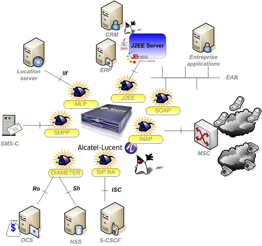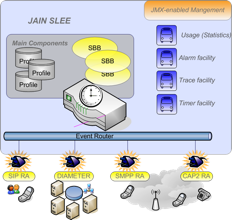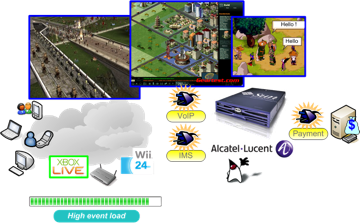Table of Contents
MFE : Réseaux de Télécommunication
Approximations pour l’évaluation de performance d’un système de télévision sur Internet
Dans un article récent (Hossfeld et al. (2008)), un modèle a été proposé pour évaluer les performances d’un système de télévision sur Internet (IPTv). Grâce à ce modèle, nous calculons la distribution du temps d’attende d’un client type connecté à ce service.
Dans ce travail, il s’agit d’adapter les algorithmes obtenus au calcul de la distribution du temps d’attente d’un client type lorsque le nombre de clients abonnés au dit service n’est pas limité. Pour ce faire, des méthodes d’approximation devront être proposées (sur base de la littérature existante), implémentées et testées afin d’en démontrer leur efficacité.
Mots clés : modélisation de système IPTV, files d’attente, analyse numérique, développement d’algorithmes
- Contact : Marie-Ange Remiche
Simulation d’un modèle mathématique en vue de l’évaluation de performance d’un système de télévision sur Internet
On demande de créer un outil de simulation d’un modèle d’un système de télévision sur Internet, IPTV (voir Hossfeld et al. (2008)). Cet outil devra être validé. Il permettra ensuite de mesurer l’efficacité des méthodes d’approximation implémentées dans un travail réalisé par un autre mémorant, ou de déterminer les axes de recherche futur concernant l’évaluation de performance du dit système.
Mots clés : modélisation de système IPTV, files d’attente, simulation et validation
- Contact : Marie-Ange Remiche
Etude des architectures liées au service IPTV
Dans un cadre général, on demande de faire une étude de la littérature existante sur les différents systèmes propres à IPTV (Télévision sur Internet). Vous devrez expliciter clairement les différentes architectures existantes, expliciter les mesures déjà effectuées dans le domaine, mettre en évidence et comparer les modèles résultants, comparer les résultats offerts par ces différents modèles.
Mots clés: architecture réseau, IPTV, protocoles, évaluation de performance
- Contact : Marie-Ange Remiche
QoS for IP/MPLS Networks
Dans ce travail, on vous demande de présenter clairement la mise en œuvre d’un service de qualité dans une architecture réseau IP/MPLS. Grâce à cette étude théorique, vous devrez déterminer le cahier des charges afin de mettre en œuvre cette architecture dans le laboratoire CISCO de la faculté, et le cahier des charges pour mettre en œuvre cette architecture dans un laboratoire composé de routeurs supportant l’OS Linux. Votre étude devra déterminer quelle solution est la plus « intéressante » pour la faculté.
Mots clés: architecture réseau, IP, MPLS, QoS, protocoles, architecture CISCO, architecture Kernel Linux
- Contact : Marie-Ange Remiche
Master Thesis in collaboration with Alcatel-Lucent
The Carrier Business Group of Alcatel-Lucent focuses on meeting the technology requirements of communications service providers. The group serves fixed, wireless and convergent service providers - as well as enterprises and governments for their business critical communications. The Carrier Business Group develops end-to-end solutions that enable those customers to profitably deploy differentiating communications services to enrich the way people live, work and play.
Telco 2.0 Business rule engine
Context: Today Telco operators face new challenges and must be able to react faster than competitors to deploy new services on market. These services are often new combination of existing services or exploitation of distributed data or resources. In the same way that BPEL can orchestrate services in Service Oriented Architecture (SOA), the telecommunication community has defined standards such as the SCIM (Service Capability Interaction Management, 3GPP TS 23.002, version 8, January 2007) in IMS architecture. However, these standards are oriented for specific environments and are not always suited for integrating different networks. For instance, a GSM call which is redirected on VoIP device and charged with DIAMETER interface, involves the Mobile switching network, the IP network and the IMS.
The R&D Carrier Applications division of ALU has developed a JAVA carrier-grade platform which implements a standard specification (JSR022/240) and which can integrate all these networks on the same application (called blended or convergent applications). The aim of the thesis is to study the possibility to create Service Interaction Engine, on that technology with an open source business rule engine.
Contribution: The thesis covers three aspects: (1) the study of the SCIM architecture and the possibility to use telecom convergent applications, (2) The study of the JSLEE technology (JSR022/240) and a feasibility study to integrate a business rule engine and finally (3) a proposed architecture and a prototype. The student will take advantage of the open source community of JSLEE around the JBoss Mobicents project, the Open Source JSLEE.
Organization: The thesis is organized by the ULB in collaboration with Alcatel-Lucent Carrier Application R&D center at Namur.
- Contacts :
Alcatel-Lucent Ventures is an internal incubator that supports teams striving to turn innovative technologies and business ideas into new products. Alcatel-Lucent Ventures is responsible for identifying game-changing ideas within Alcatel-Lucent’s Bell Labs research organization, incubating them into products, and finding the right mechanism to bring them to market. In this context a unity of the bell labs R&I of Antwerp and of the Carrier R&D Namur have launched the World Wide Game Project (W²G).
Convergent Mobile Gaming Platform: W²G Project
Context: Nowadays, electronic games have become one of the most important sources of entertainment, especially Massive Multiplayer Games (MMG). The key concept in these games is to play with a significant number of other players. However, these kinds of games are restricted to specific consoles, such as Nintendo or Playstation, or PC.
Despite increasing mobility demand and more powerful mobile devices, no platform allows to support such games on mobile. Providing such a carrier-grade gaming server would open new landscapes. By accessing operator networks we will enable different devices to use the same game; by providing an access to the mobile subscription, a user could pay a participation fee directly from his prepaid account. In addition, the gaming server coupled to the ALU advertising server would allow a user to receive advertising and thus pay less to access the game. Moreover, we leverage a community of players : imagine the same game played everywhere, every time, always connected with your friends, regardless of which operator provides your service.
Thesis 1: Gaming server Business Logic layer
Contribution: The major risk of this project is the investment of the Game Company to write the server logic code. That is why we propose to implement an abstraction layer on top of the gaming server and let the game developer define graphically the logic of the server-side game. The thesis has three main objectives: (1) study the BPEL language and the requirement of Game development companies in term of business logic definition, particularly for MMPG, (2) the study of an open source JAVA BPEL engine and the JSLEE technology (JSR022/240) and finally (3) a proposed-architecture according to game needs.
Organization: This thesis is organized by the ULB in collaboration with Alcatel-Lucent Bell Labs Research & Innovation at Antwerp and the Carrier R&D at Namur.
- Contacts :
Thesis 2: Mobile game development
Contribution: The aim of this thesis is to develop a JAVA version with a subset of features of an existing MMP game on a mobile: Star wars Combine. This thesis will be splited for two students. In the first part the student will (1) study the J2ME architecture and the GPRS protocol, (2) implement a prototype of the game based on the SW Combine data model on a mobile phone. While the second part will focus on (1) the study of the JSLEE technology, (2) a study of the particular needs of the MMP games and (3) an implementation of the server side logic of the game developed in the first subject.
Organization: This thesis is organized by the ULB in collaboration with Alcatel-Lucent Bell Labs Research & Innovation at Antwerp and the Carrier R&D at Namur.
- Contacts :





